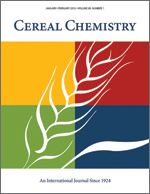
Cereal Chem 61:136 - 140. | VIEW
ARTICLE
Toast Bread from Defatted Wheat Flour.
Y. Pomeranz, A. W. El-Baya, W. Seibel, and H. Stephan. Copyright 1984 by the American Association of Cereal Chemists, Inc.
Toast bread was baked from nondefatted and from petroleum-ether defatted flour of medium protein content and strength. The formulation included 5% peanut oil or fat, 0.2-0.4% diacetyltartaric acid esters or lecithin, 0.1-0.2% polar wheat flour or wheat gluten lipids, 0.55% nonpolar wheat flour or wheat gluten lipids, and combinations of 5% fat or oil and emulsifiers or wheat flour lipids. Whereas peanut oil and fat were equally effective in increasing loaf volume, bread baked with fat had significantly superior crumb characteristics. Diacetyltartaric acid esters were more effective in increasing loaf volume, bread baked with fat had significantly superior crumb characteristics. Diacetyltartaric acid esters were more effective than lecithin in increasing loaf volume and in imporoving crumb characteristics. Polar wheat flour lipids had an intermediate effect. Oil, in combination with emulsifiers or wheat flour polar lipids, improved loaf volume and crumb characteristics. Surfactants, alone or in combination with 5% oil or fat, had a more pronounced effect when added to defatted rather than to nondefatted flour. Increasing the amounts of surfactants within the limits used in this study increased loaf volume and usually improved bread crumb characteristics. When added to defatted flour, wheat flour polar lipids were more effective than nonpolar lipids, which were more detrimental than corresponding lipids extracted from vital commercial gluten. The difference is related to the composition of the extracted and fractionated lipids. Baking scores and softness retention were usually positively related to loaf volume.